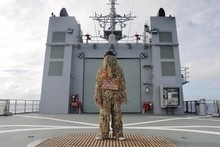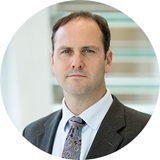Pristine Ocean Needs to Become Sanctuary
 John Reynolds' gillie guise was a spooky sight for HMNZS Otago sailors. Photo / Jason O'Hara
John Reynolds' gillie guise was a spooky sight for HMNZS Otago sailors. Photo / Jason O'Hara
A trip to the Kermadecs by nine artists on the HMNZS Otago has spawned a touring art exhibition which underpins efforts to protect the region. Linda Herrick reports
If there was one thing Auckland artist John Reynolds longed to do aboard the HMNZS Otago as he and eight queasy colleagues sailed north towards Raoul Island last May, it was to broadcast the daily 6.45am call on the ship's tannoy: "Wakey wakey wakey! All hands! Wakey wakey wakey!"
Very effective, chirpy - and relentless. Reynolds' hopes of performing a variation on the summons to arise were high. But then he donned his camouflage suit (a gillie, used by hunters and snipers) and bowler hat, and posed for a photo on the ship's helipad.
"The sailors got very spooked by that," he recalls, laughing. "I should have done it before I put the suit on. I had talked to some of the officers and I was very interested in what they did and I seemed like a reasonable person. But the moment I put the suit on and went out for a photo, that blew out of the water any chance of me being allowed to address the whole boat.
"I have worn that suit in supermarkets and all sorts of public places," he adds. "There are only two reactions - people smile and walk by, or they look at me as though I don't exist. The sailors walked by me without looking."
Reynolds and his mates - writer-artist Greg O'Brien, sound artist Phil Dadson, photographers Jason O'Hara and Bruce Foster, and artists John Pule, Fiona Hall, Elizabeth Thomson and Robin White - endured two days of claustrophobia and seasickness on the high seas to get to Raoul Island, which houses a DoC base.
Their journey was initiated by the Washington-based charitable trust Pew Environment Group's Global Ocean Legacy as part of a drive to raise public awareness of the pristine 620,000sq km Kermadec marine reserve. The reserve, which falls within New Zealand's exclusive economic zone, is home to a wild underwater geography and a vast range of marine species, many still unknown; just last week a "super-giant" prawn was discovered by a Scottish science team.
The aim of Pew and its supporters is to encourage our Government to protect the region for all time as the Kermadec Ocean Sanctuary, entirely free from fishing and mineral exploration, making it the biggest marine reserve in the world.
Pew, which has offices around the world, including Wellington, is supported financially by a number of American philanthropists, including Julian Robertson, who gifted a collection of art to Auckland Art Gallery and, reputedly, one of the biggest-name directors in Hollywood.
The Kermadec artists' project came about, says Greg O'Brien, after a Pew-sponsored science symposium on the region at Te Papa in 2010, which also involved the navy and the Department of Conservation.
"They came up with this idea that they would send some people to the Kermadecs on a naval boat and balance the discussion that might come with science awareness and conservation with something that might exist with a group of artists. I knew it would be an electric, magical thing to go there. Really, you could ask anyone to go there. We started off with visual artists and everyone jumped on board immediately and at that point, because of the limited room on the boat, we left it at that."
At that stage, like many people, O'Brien wasn't even sure where the Kermadecs were on the map, nor that the Kermadec Ridge absorbs a long line of more than 50 submerged live volcanos that start with White Island in the Bay of Plenty and continue north, with strangely sweet names such as Rumble (I-V), Lillie and Brothers, while the massive Kermadec-Tonga Trench, which lies parallel to the east, descends more than 10km below the surface of the sea.
O'Brien, while excited about the destination, found the journey arduous, with six tiny bunks per cabin, no windows below deck and very rough seas. He found some relief by jumping overboard when the Otago reached the Tropic of Capricorn, with the swimmers watched over by a sailor armed with a rifle in case of sharks.
After two days of vibration, rolling and pitching, the artists rose eagerly at dawn as Raoul Island emerged on the horizon, wreathed in pink powder-puff clouds.
"It was like something out of a movie," says O'Brien, "it was like a reprieve, almost like being reborn on dry land ... because I had such an intense experience of being on the boat, once we got on to the island" - by jumping from a dinghy and clambering up rocks; the vertiginous island has no jetty - "you found yourself walking along very soft, verdant, grassy earth. It was very intense and we realised we were in a completely different climate zone. The air was almost buzzing with moisture, there were parrots flying around, you were aware that this was the new world for the moment."
Reynolds says it was hard not to view the island in "pirate terms". "It did loom out of the morning mist, and it was satisfyingly wind-swept and barren in areas and strongly 'pohutakawa'd' in others.
"There was a real sense of expectation that we would be able to stretch our legs and be artists instead of passengers on a naval boat.
"The DoC people thought they could escort us around the island, but the job description of an artist is that you are an independent individual and we were there to explore, so we were off, like a swarm of kittens."
Earlier efforts to settle and tame Raoul have failed, most famously for the Bell family from Yorkshire, who lived there from 1878-1914, finally defeated by the terrain, inaccessibility from the sea, violent cyclones and volcanic activity. DoC worker Mark Kearney was killed there by an eruption in March 2006.
"I found the whole place was very blissful," observes O'Brien, "but I was aware that you could be lulled into a sense of false security. The ground was soft, but it was precipitous.
"It's an unregulated, unforgiving place. There is no easy way on or off. It is quite paradoxical - one of the most beautiful places I have ever been but one that has a complicated personality with weird bits of steam coming out of the cliff sides, weird plants everywhere."
After 48 hours on the island, the group returned to the Otago, sailing on up to Tonga.
Since then, each artist has found different ways of expressing their Kermadec experience, with photos, poetry, video interviews, sound, paintings and prints and, in the case of Robin White and Fiona Hall, tapa.
The collection of works, which has continued to grow, was first exhibited in the Tauranga Art Gallery, moving into Auckland's Maritime Museum from next Wednesday, with hopes that it will later travel to London, the Hamburg Book Fair and Washington.
In the book which accompanies the show, each artist has written about the effect the voyage had on them, and why the Pew project matters: the National Government has still not made a decision on the Kermadec Ocean Sanctuary.
"The challenge is to try and find a voice, an effective voice, for expressing concerns about the very real threat this part of the ocean is under," writes Reynolds in the book. "... The perils are sloganism and some kind of trite reference to issues that are complex - but a greater peril is not taking that risk."
Reynolds says: "We understand from Pew that individually and privately the entire National Government caucus before the last election agreed this was a worthy cause.
"However, that didn't translate into political will to simply enact the legislation. This would be huge kudos for New Zealand, it would deliver real status to New Zealand in terms of leadership, showing initiative to do something about the environment.
"This National Government simply has to feel the heat. We are hoping to take the show to Frankfurt, then Washington.
"If a minister or ambassador can't stand up at the opening and announce that the legislation has been passed, if they can't get good news out within the next six months, then they don't understand the PR opportunity."
You could say that Reynolds has finally been able to make his "wakey wakey wakey" call.
Link to NZ Herald












